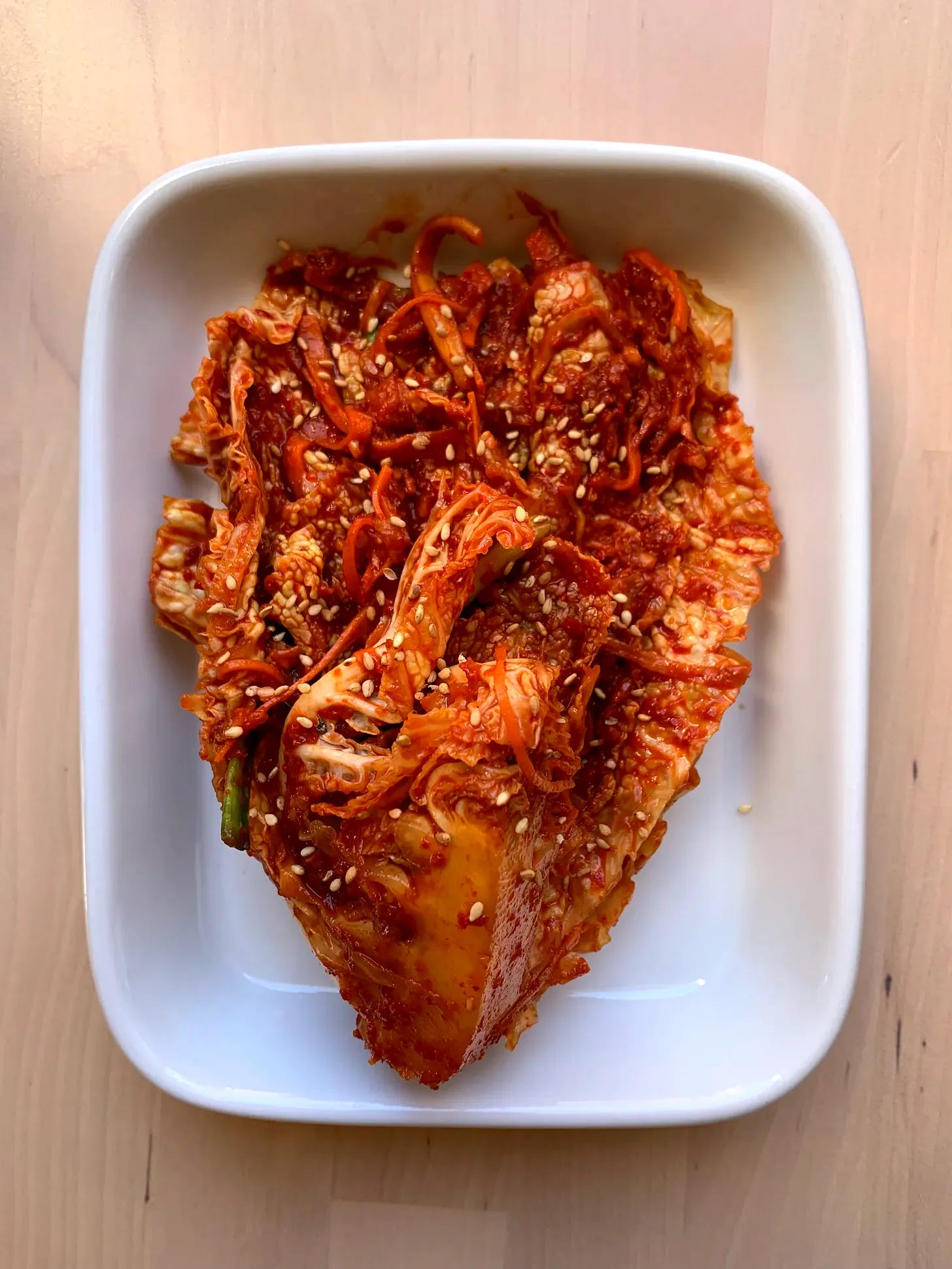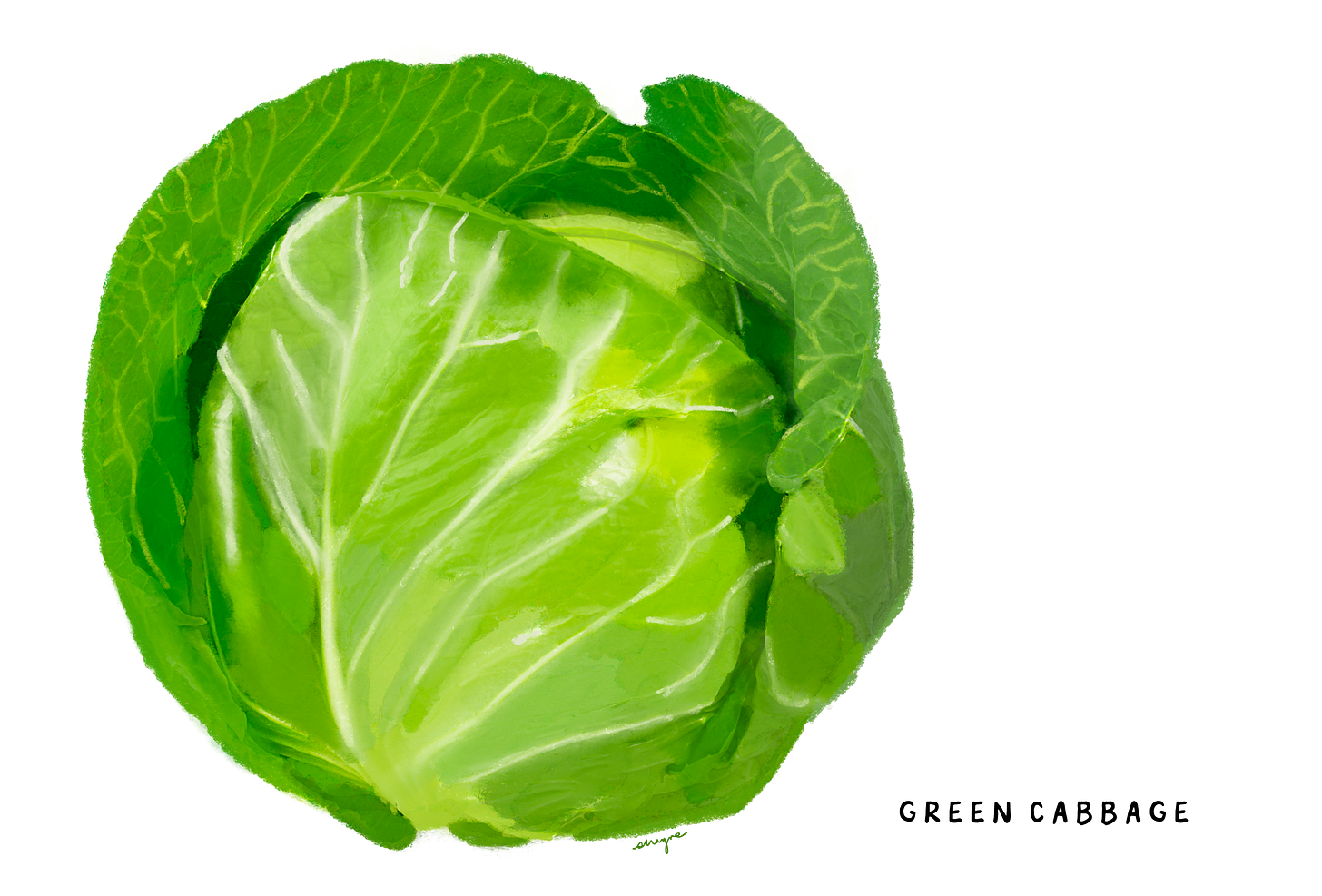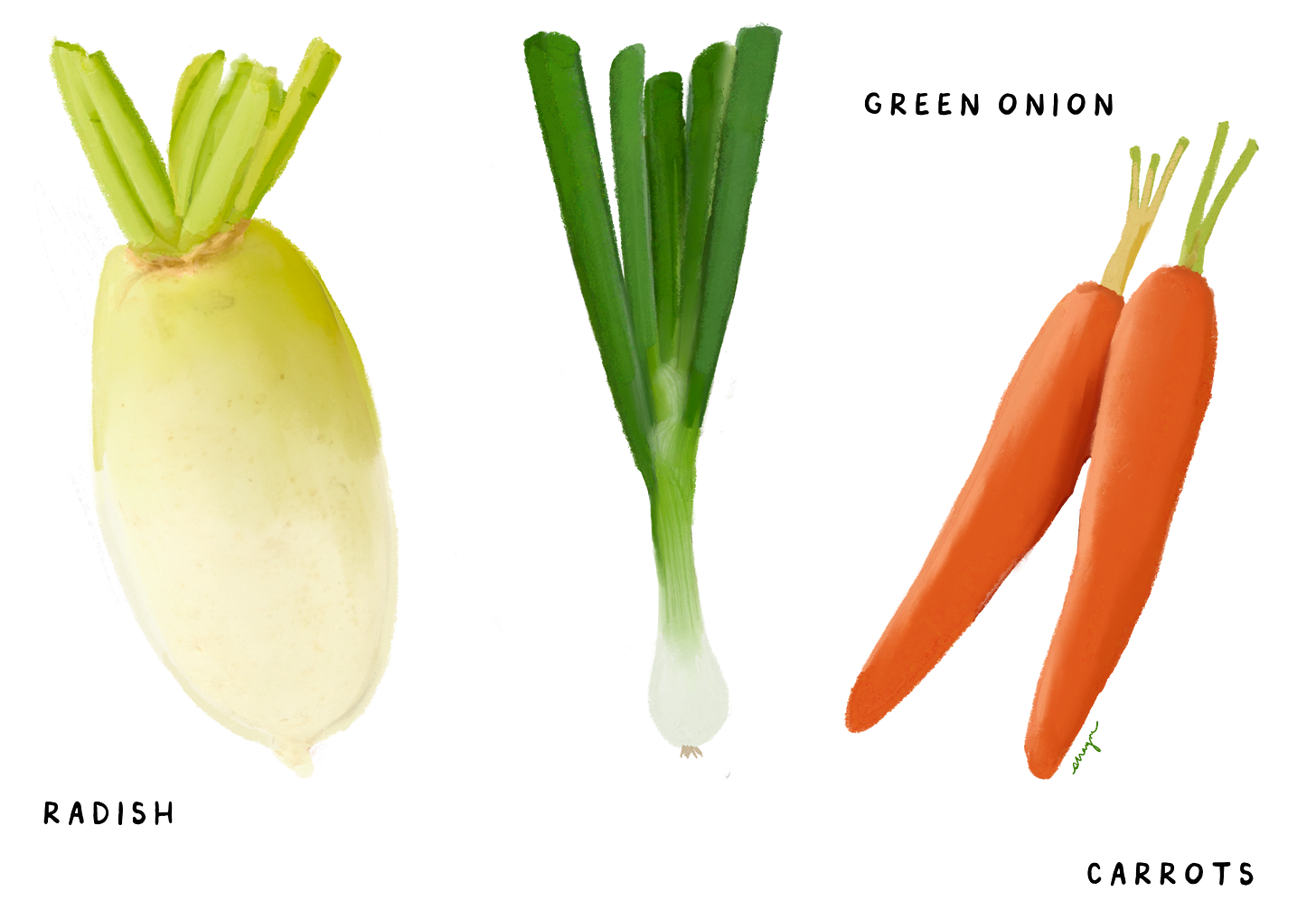Crossroads, No. 10: Janey Lee's "Catalan-ish" Kimchi
How do you eat "locally" in a place whose cuisine isn't your own?
**Just as a heads up: some of the links in this post are affiliate links, meaning I’ll earn a small commission at no extra cost to you if you decide to purchase the amazing books, ingredients, etc. through them. Thank you ever so much in advance for your support of this newsletter ❤️
Crossroads is a column about cooking and eating at the crossroads of multiple cultures. We explore dishes created from immigrants’ resourcefulness and creativity as they create the foods of their homeland while having to make do with the ingredients they have available to them in their new environment. This isn’t “fusion cuisine” (as in, the kind of stuff that would be served at a restaurant or marketed to the masses), but rather, food that’s part of a quirky, in-between cuisine reflective of where they’re from and where they currently live—something rooted simultaneously in tradition and innovation. You can check out TOD’s archive of past recipes here.
When I was scrolling through my Substack feed sometime last year, I couldn’t help but do a double-take seeing a post from Korean-American food writer Janey Lee titled “Catalan-ish Kimchi” through her biweekly newsletter, “I Have a Question.” Janey’s lived in Barcelona for the past four years, working a day job in UX design while using Substack as an outlet for sharing personal stories and reflections from her kitchen, as well as documenting everything she’s learned from conversations with Catalonia’s farmers, foragers, and makers.
We’re currently living in the age of the culinary “-ish,” and this shouldn’t come as a surprise for those who’ve followed “That One Dish" for a while. The most compelling voices in food have increasingly been from diasporic creators actively pushing back against the pressure to present their cultures as singular or static. Instead of offering neatly-packaged definitions of “authenticity,” they’re embracing the lived realities of adaptation and in-betweenness—challenging the idea that a cuisine can or should be distilled into one fixed narrative. It’s a theme that continues to inform the stories and recipes I share here, which is why my ears perk up and my pupils dilate whenever I see the word “-ish” floating around the Internet in regards to third-culture cooking.
So, how does the “-ish” in “Catalan-ish” kimchi “-ish?” And how did that “-ish” start “-ishing?”
On a phone call with her several months later, Janey tells me that she grew up in the United States, but moved to Korea with her family at 13 years old after her father secured a job there. There, she attended international school along with other Korean-Americans and foreigners.
“At the time I had zero percent interest in Korean culture, history, language, whatever,” she says. “My main interest was making friends at school and doing after-school activities. I guess what it did give me were friendships that are my oldest, deepest ones. So, it wasn’t like Korean culture was wasted on me, because when I meet up with those friends again we’re on this journey to explore other parts of our culture we didn’t get to in high school because all these other things were more important.”
She returned to Chicago for college, but was bitten by the travel bug shortly afterward and began her journey abroad—working at a strategy and design firm in Mumbai and at Spotify’s headquarters in Stockholm before coming to Spain. “I had a coworker on my team [at Spotify] based in Barcelona,” Janey recalls. “I said, ‘I’m dying here in the cold [in Stockholm]. She told me, ‘Come to Barcelona, hang out here for a month and work remotely. We’re in a pandemic, nobody’s looking. Then I came and fell in love. It’s just a super vibrant place.”
Building a life across continents, it was through everyday acts—learning to cook familiar dishes, stumbling through new vocabulary—that her curiosity about Korean culture began to take root. It was often in the kitchen, she found herself slowly turning back toward a heritage she hadn’t always known how to claim.
“It’s a work in progress. I recently started taking Korean classes, and I did that because I realized how much time I was spending learning Spanish and Catalan—and I thought, why am I not learning my own language? It took my curiosity about other cultures to realize, wait, I also have a culture? I wasn’t directing my curiosity towards there and it was only about three, four years ago that I realized that I hadn’t been engaged in Korean culture. I found a Korean teacher here in Barcelona, which is so crazy. There’s a school of Asian languages in my neighborhood, and we’ve been doing classes once a week. In general, I keep going back to Korea because my parents still live there and I’m getting more interested in my own family history. I got into cooking during the pandemic when I was in Sweden. Recreating my Korean upbringing was a big part of why I wanted to learn to make different dishes. I want to also work in public and share my journey with people.”
That’s where her newsletter, “I Have a Question” comes in, where she explores everything from how chickens are being raised at DeBosc to making croquetas from leftover carcasses and heads from her local fishmonger. Its name comes from the overarching goal of feeding into your natural curiosity about everything that we’re doing—especially when it comes to the food we eat.
“Writing is how I process the world. I was growing more and more interested in cooking, and for a long time food and cooking has been a lens through which I was learning and understanding a lot of other things including my family history, Korean history, sustainability, farming, and agriculture. I’m thinking more deeply about a plate that’s in front of you, where it all came from. I kept going down these rabbit holes of bigger questions for biger topics, I want to use my newsletter as a way to reflect on those things. I always feel like cooking was the starting point. [My interest in eating and cooking locally] really comes from the kind of books I’ve read on where everything comes from; sustainability has always been top of mind for me. It’s why I feel it’s so important to support local farmers. It’s nice to know who raised your chickens; one of my first posts on the newsletter was about me visiting a chicken farm and learning about what it takes to raise one. I wish I could do that for everything I eat—tracing it back to the source.”
Though Janey advocates for farmers’ markets, sourcing food locally, and mindful, low-waste cooking in her work, her own desire for the foods of her motherland inevitably leads her right to one of the Asian grocery stores found in her neighborhood—face-to-face with the gochugaru, ramyeon, and rice cakes flown in from elsewhere. These aren’t just ingredients, but quiet anchors and reminders of a culinary language she knows by heart. Eating them offers a kind of comfort and sense of continuity in a place that still feels somewhat provisional, and yet that comfort is complicated. The environmental cost of importing food she associates with home is hard to ignore. At the same time, limiting herself strictly to what’s local can feel like a slow erasure of the flavors that shaped her.
So, what does it mean for Janey to make kimchi “locally?”
Note that the method illustrated below—I mean this literally and figuratively—is a direct reprint of what Janey wrote in her original post. Please consider subscribing to her newsletter for thoughtful dispatches on eating locally and sustainably in Barcelona, home cooking tips, and fun food-related expressions in one of the many languages she’s learning.
“While I could make kimchi with Napa cabbage from any Asian store, I find that the locally grown cabbage is just as suitable,” Janey writes in her post. “It has both thick, crunchy parts and tender, leafy parts. It wilts down well when salted, and you can cut it in quarters to store, just like you would with Napa cabbage.” She begins by washing cabbage, then generously salting the leaves and leaving it overnight. This draws out the moisture from the leaves, which will help in preserving the kimchi.
The next day, she squeezes out the water and moves onto the additional vegetables—julienned carrot, radish, green onion, and some garlic. “Thankfully, all of these ingredients are readily available [in Barcelona],” Janey writes in her post. “The radish isn’t quite as sweet as the ones you get in Korea, but I don’t think it matters.”
“You could also put any other vegetable in there,” she elaborates to me over the phone. “Eric Kim had a post about how to ‘kimchi’ anything, and that’s very much the vibe here. Any vegetable that makes sense can be put into the filling. I’d encourage people to try different things.”
Onto the fish sauce and shrimp paste. From Janey’s post: “I learned only in the last couple years that what makes kimchi taste ‘good’ or ‘as I remember it’ is actually its use of seafood products. This is because my mother’s side of the family is from the Jeolla region of Korea, where seafood from the western coast is abundant … When I discovered Josh Niland’s garum recipe in ‘Take One Fish.’ I thought that maybe it’d be possible to use the guts and spines of a local Mediterranean fish to replace the traditional Korean shrimp jeot (paste) and fish sauce.”
“There’s a quote I wrote down that I wanted to share with you,” Janey says to me during our phone call. “He has one quote from his main book: ‘My priority is to maximize the yield from one single fish, which I firmly believe should not be seen as something we only take fillets from. This kind of thinking is lazy and neglectful, and will only continue to result in the widespread depletion of our oceans.’ I was really inspired by that because I found it to be another profound way in which cooking isn’t just cooking; the choices we make with what we eat affect the world and the ecosystem. Josh has a recipe in that book for garum, which is a fermented fish sauce that dates back to ancient Rome.”
(A little aside: we’ve featured Josh’s recipe for custard tart with fish sauce caramel before on this newsletter, which you can find linked here for a little throwback).
“To produce the garum, calculate the total weight of heads, bones and straps you have from small fish such as sardines, mackerel, anchovies, or gurnard (make sure that the gallbladder is removed as it will make the finished sauce extremely bitter). Measure 50 percent of that weight in water and add to the trimmings. Calculate 20 percent of the combined weight and add this quantity of fine salt. Mix together, then transfer to a mason (kilner) jar, seal and place in a circulator bath set to 104°F. Leave for seven days, stirring once a day. Once it’s ready, store the garum in a sterilized mason jar or airtight container in the fridge for up to a month".”
excerpted from Josh Niland’s “Take One Fish”
“I tried it, and I did get something that tasted very fishy—which is why I tried to put that in my kimchi. Kimchi always requires something that’s kind of savory, fishy, so you can really put any mix of things. I’ve also seen my mom use anchovy juice; she’d get fresh anchovies, and whatever liquid came with it, she’d put it in.”
Onto the slurry, traditionally made by mixing rice flour with water, which serves as a nice adhesive for the spice paste to stick to the cabbage leaves and other vegetables. “Once, I took a spoon or two of old rice, cooked it in water until the grains lost their shape, and it became a slurry. (Blending would also aid the process),” Janey writes. “There is plenty of rice that grows in Catalunya, so it would definitely be possible to make a rice slurry with local rice.”
The final component of any kimchi is the red pepper flakes, the gochugaru—and I hate to break it to you all, but it just isn’t possible to substitute.
“If you’re someone who didn’t grow up eating kimchi and you want to experiment with different kinds of pepper powders, I am totally okay with that. For the flavor I’m looking for, we gotta have the gochugaru.”
“Early on in my kimchi-making days, I mistakenly used Thai chili to make kimchi,” Janey confessed in her post. “It did not taste good. I complained to my mom, and she reminded me that Korean food can only be made with Korean ingredients. I think she’s right, and I don’t really have much interest in making kimchi with anything that isn’t gochugaru from Korea. I am a relatively open person—but on this matter, I find myself on the conservative end. Of course, with any other type of pepper, you could probably make something similar, but it just wouldn’t have the taste I’m personally looking for. (But perhaps I should try opening my mind on this.)”








